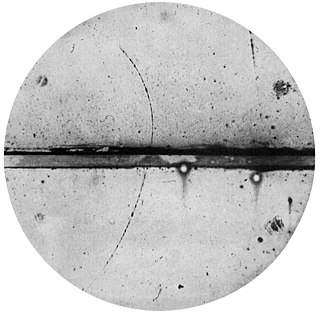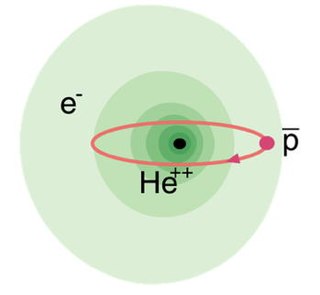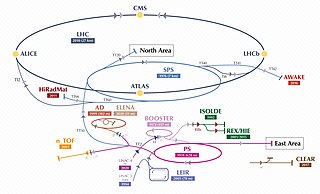
In modern physics, antimatter is defined as matter composed of the antiparticles of the corresponding particles in "ordinary" matter. Minuscule numbers of antiparticles are generated daily at particle accelerators—total artificial production has been only a few nanograms—and in natural processes like cosmic ray collisions and some types of radioactive decay, but only a tiny fraction of these have successfully been bound together in experiments to form antiatoms. No macroscopic amount of antimatter has ever been assembled due to the extreme cost and difficulty of production and handling.

The European Organization for Nuclear Research, known as CERN, is a European research organization that operates the largest particle physics laboratory in the world. Established in 1954, the organization is based in a northwest suburb of Geneva on the Franco–Swiss border and has 23 member states. Israel is the only non-European country granted full membership. CERN is an official United Nations Observer.

Carlo Rubbia is an Italian particle physicist and inventor who shared the Nobel Prize in Physics in 1984 with Simon van der Meer for work leading to the discovery of the W and Z particles at CERN.

The antiproton,
p
, is the antiparticle of the proton. Antiprotons are stable, but they are typically short-lived, since any collision with a proton will cause both particles to be annihilated in a burst of energy.

Simon van der Meer was a Dutch particle accelerator physicist who shared the Nobel Prize in Physics in 1984 with Carlo Rubbia for contributions to the CERN project which led to the discovery of the W and Z particles, the two fundamental communicators of the weak interaction.
Protonium, also known as antiprotonic hydrogen, is a type of exotic atom in which a proton and an antiproton orbit each other. Since protonium is a bound system of a particle and its corresponding antiparticle, it is an example of a type of exotic atom called an onium.

Antiprotonic helium is a three-body atom composed of an antiproton and an electron orbiting around a helium nucleus. It is thus made partly of matter, and partly of antimatter. The atom is electrically neutral, since both electrons and antiprotons each have a charge of −1, whereas helium nuclei have a charge of +2.

The Bevatron was a particle accelerator — specifically, a weak-focusing proton synchrotron — at Lawrence Berkeley National Laboratory, U.S., which began operating in 1954. The antiproton was discovered there in 1955, resulting in the 1959 Nobel Prize in physics for Emilio Segrè and Owen Chamberlain. It accelerated protons into a fixed target, and was named for its ability to impart energies of billions of eV.

The ISR was a particle accelerator at CERN. It was the world's first hadron collider, and ran from 1971 to 1984, with a maximum center of mass energy of 62 GeV. From its initial startup, the collider itself had the capability to produce particles like the J/ψ and the upsilon, as well as observable jet structure; however, the particle detector experiments were not configured to observe events with large momentum transverse to the beamline, leaving these discoveries to be made at other experiments in the mid-1970s. Nevertheless, the construction of the ISR involved many advances in accelerator physics, including the first use of stochastic cooling, and it held the record for luminosity at a hadron collider until surpassed by the Tevatron in 2004.

The Proton Synchrotron is a particle accelerator at CERN. It is CERN's first synchrotron, beginning its operation in 1959. For a brief period the PS was the world's highest energy particle accelerator. It has since served as a pre-accelerator for the Intersecting Storage Rings (ISR) and the Super Proton Synchrotron (SPS), and is currently part of the Large Hadron Collider (LHC) accelerator complex. In addition to protons, PS has accelerated alpha particles, oxygen and sulfur nuclei, electrons, positrons, and antiprotons.
Gerald Gabrielse is an American physicist. He is the Board of Trustees Professor of Physics and Director of the Center for Fundamental Physics at Northwestern University, and Emeritus George Vasmer Leverett Professor of Physics at Harvard University. He is primarily known for his experiments trapping and investigating antimatter, measuring the electron g-factor, and measuring the electron electric dipole moment. He has been described as "a leader in super-precise measurements of fundamental particles and the study of anti-matter."

The Antiproton Decelerator (AD) is a storage ring at the CERN laboratory near Geneva. It was built from the Antiproton Collector (AC) to be a successor to the Low Energy Antiproton Ring (LEAR) and started operation in the year 2000. Antiprotons are created by impinging a proton beam from the Proton Synchrotron on a metal target. The AD decelerates the resultant antiprotons to an energy of 5.3 MeV, which are then ejected to one of several connected experiments.
The Low Energy Anti-Proton Ring (LEAR) was a particle accelerator at CERN which operated from 1982 until 1996. The ring was designed to decelerate and store antiprotons, to study the properties of antimatter and to create atoms of antihydrogen. Antiprotons for the ring were created by the CERN Proton Synchrotron via the Antiproton Collector and the Antiproton Accumulator. The creation of at least 9 atoms of antihydrogen were confirmed by the PS210 experiment in 1995.
Atomic Spectroscopy and Collisions Using Slow Antiprotons (ASACUSA), AD-3, is an experiment at the Antiproton Decelerator (AD) at CERN. The experiment was proposed in 1997, started collecting data in 2002 by using the antiprotons beams from the AD, and will continue in future under the AD and ELENA decelerator facility.

The Low Energy Ion Ring (LEIR) is a particle accelerator at CERN used to accelerate ions from the LINAC 3 to the Proton Synchrotron (PS) to provide ions for collisions within the Large Hadron Collider (LHC).

The Antiproton Accumulator (AA) was an infrastructure connected to the Proton–Antiproton Collider – a modification of the Super Proton Synchrotron (SPS) – at CERN. The AA was built in 1979 and 1980, for the production and accumulation of antiprotons. In the SppS the antiprotons were made to collide with protons, achieving collisions at a center of mass energy of app. 540 GeV. Several experiments recorded data from the collisions, most notably the UA1 and UA2 experiment, where the W and Z bosons were discovered in 1983.

Vinod Chandrasinh Chohan was a Tanzanian-born accelerator specialist and engineer. He was a Senior Staff Member at CERN for nearly 40 years.
AEgIS, AD-6, is an experiment at the Antiproton Decelerator facility at CERN. Its primary goal is to measure directly the effect of Earth's gravitational field on antihydrogen atoms with significant precision. Indirect bounds that assume the validity of, for example, the universality of free fall, the Weak Equivalence Principle or CPT symmetry also in the case of antimatter constrain an anomalous gravitational behavior to a level where only precision measurements can provide answers. Vice versa, antimatter experiments with sufficient precision are essential to validate these fundamental assumptions. AEgIS was originally proposed in 2007. Construction of the main apparatus was completed in 2012. Since 2014, two laser systems with tunable wavelengths and synchronized to the nanosecond for specific atomic excitation have been successfully commissioned.

The Super Proton–Antiproton Synchrotron was a particle accelerator that operated at CERN from 1981 to 1991. To operate as a proton-antiproton collider the Super Proton Synchrotron (SPS) underwent substantial modifications, altering it from a one beam synchrotron to a two-beam collider. The main experiments at the accelerator were UA1 and UA2, where the W and Z boson were discovered in 1983. Carlo Rubbia and Simon van der Meer received the 1984 Nobel Prize in Physics for their decisive contribution to the SppS-project, which led to the discovery of the W and Z bosons. Other experiments conducted at the SppS were UA4, UA5 and UA8.
Extra Low ENergy Antiproton ring (ELENA) is a 30 m hexagonal storage ring that decelerates antiproton beams and delivers it to different AD experiments. It is situated inside the Antiproton Decelerator (AD) complex at CERN, Geneva. It is designed to further decelerate the antiproton beam coming from the Antiproton decelerator to an energy of 0.1 MeV for more precise measurements. The first beam circulated ELENA on 18 November 2016. The ring is expected to be fully operational by the end of the Long Shutdown 2 (LS2) in 2021.












